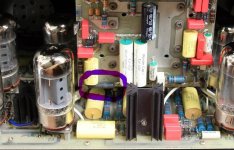Dear Hive mind,
I have an AR D125 and there has been a component that has burnt out.
I have traced it to being R174 400 Ohm, 7W OR F3 1/8A fuse.
Are these the same component? It is a blue glass device that does not look like a resistor.
I have attached pictures of the schematic and the unit with the compenent in question.
I need to replace this device so any help would be greatly appreciated.
Thanks
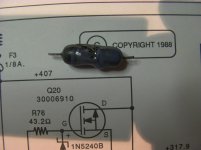

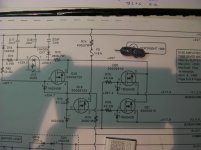
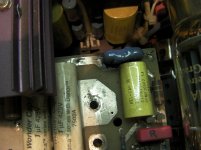
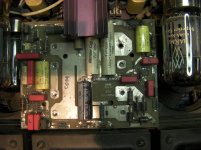
I have an AR D125 and there has been a component that has burnt out.
I have traced it to being R174 400 Ohm, 7W OR F3 1/8A fuse.
Are these the same component? It is a blue glass device that does not look like a resistor.
I have attached pictures of the schematic and the unit with the compenent in question.
I need to replace this device so any help would be greatly appreciated.
Thanks





Seems there is a 400R resistor in series with the fuse, according to the schematic.
The resistor is 7W, so it is fairly large, and should be easy to locate. However, it's
possible that the schematic does not accurately reflect the board.
This problem probably indicates other problems elsewhere in the circuit though.
The resistor is 7W, so it is fairly large, and should be easy to locate. However, it's
possible that the schematic does not accurately reflect the board.
This problem probably indicates other problems elsewhere in the circuit though.
Last edited:
I'd triple check one end is to the 425V rail or directly connected to Q18,19,20 and Q21 (easier)
There's no way thats a 7W resistor so if you're in the right area you should also be able to spot the 7W resistor (and confirm it's value) it may be off board or mounted on the back side?
There's no way thats a 7W resistor so if you're in the right area you should also be able to spot the 7W resistor (and confirm it's value) it may be off board or mounted on the back side?
Yes that was a 400Ω 7watt-ish resistor. Some pictures on line show a shiny purple/green resistor there.
I'm sure there is a problem elsewhere... sorry.
I'm sure there is a problem elsewhere... sorry.
Attachments
Last edited:
Ouch! That got well hot, it's a wonder there was no fire,something is pulling serious current, look for shorts. Looking at the fuse might be illuminating,if the element has vaporised with a silver sheen on the glass it indicates a gross SC.
AR amps are notorious for complex power supply's, lot's of factory selected trannys available only from AR for a wedge, I don't envy you this repair. Good luck.
AR amps are notorious for complex power supply's, lot's of factory selected trannys available only from AR for a wedge, I don't envy you this repair. Good luck.
Thank you people.
There is no fuse in series with this component, I have tested continuity at the terminals and one side is the +420 rail, the other is R73, Q18-21. I have never seen a resistor like this before.
There are no other "burn" marks that I can see on this or any other PCB.
So although I agree this device would only blow after sustained high current I can see no other evidence of it. Thus, I will need to test that the transistors are not shorted.
If there are any other suggestions I would welcome the input.
There is no fuse in series with this component, I have tested continuity at the terminals and one side is the +420 rail, the other is R73, Q18-21. I have never seen a resistor like this before.
There are no other "burn" marks that I can see on this or any other PCB.
So although I agree this device would only blow after sustained high current I can see no other evidence of it. Thus, I will need to test that the transistors are not shorted.
If there are any other suggestions I would welcome the input.
Put a normal resistor and check how it behaves ... if there are no shorts could be a tube with issues for example .
Thank you people.
There is no fuse in series with this component, I have tested continuity at the terminals and one side is the +420 rail, the other is R73, Q18-21. I have never seen a resistor like this before.
There are no other "burn" marks that I can see on this or any other PCB.
So although I agree this device would only blow after sustained high current I can see no other evidence of it. Thus, I will need to test that the transistors are not shorted.
If there are any other suggestions I would welcome the input.
As suggested on HiFi Wigwam this is most likely flame proof fusible resistor hence applied some sort of shielding around , one of the photos attached earlier showing different type suggest that original resistor must have "fused" and has been replaced with wirewound resistor.
This 400R/7W resistor acts like a fuse around 0.125A as stated on wiring diagram, don't use in this position standard 7W resistor .
Most likely there is a problem with screen grid on one or more power tubes and very likely some other component/components failed - check all transistors and diodes .
It looks like you might struggle to find such a high value/wattage fusible resistor , best would be to get in touch with Audio Research and see what they have to say but if you decide to repair it use higher wattage wirewound resistor with a fuse in series but you really need to check all other components an power tubes beforehand
Whatever you do put back in place you need to sort out the carbonised board !
There's a 390 available from Vishay with a suitable voltage rating
Vishay 390Ω Wire Wound Resistor 7W +-5% RWM06223900JA15E1 | RS Components
There's a 390 available from Vishay with a suitable voltage rating
Vishay 390Ω Wire Wound Resistor 7W +-5% RWM06223900JA15E1 | RS Components
Last edited:
Thanks peeps,
I am now struggling to find a source for a 400 Ohm, 7W fusible resistor. Any ideas gratefully received.
While I try to find and order thsi part I will test diodes and transistors in the power supply.
Slav, how do I test the grids?
I am now struggling to find a source for a 400 Ohm, 7W fusible resistor. Any ideas gratefully received.
While I try to find and order thsi part I will test diodes and transistors in the power supply.
Slav, how do I test the grids?
As mentioned earlier use Stansted wirewound 390R 7W or 10W in series with a .125A fuse
Good luck
Good luck
Missed that bit about testing screen grid , you’d need tube tester , are these power tubes old? I could test power tubes for you , I’m in Shenfield, Essex but it won’t be very quick as I’m working away for another couple of weeks
Slav,
The tubes are new and were still being burnt in when the fusible resitor gave way.
Further investigations point to the MOSFET suppplying the grid voltage to the left channel tubes.
Have you any clue what the specs are for those MOSFETS (Q20, Q21 pn:30006910)?
thanks again
The tubes are new and were still being burnt in when the fusible resitor gave way.
Further investigations point to the MOSFET suppplying the grid voltage to the left channel tubes.
Have you any clue what the specs are for those MOSFETS (Q20, Q21 pn:30006910)?
thanks again
- Home
- Amplifiers
- Tubes / Valves
- Audio Research D125 Blown up
